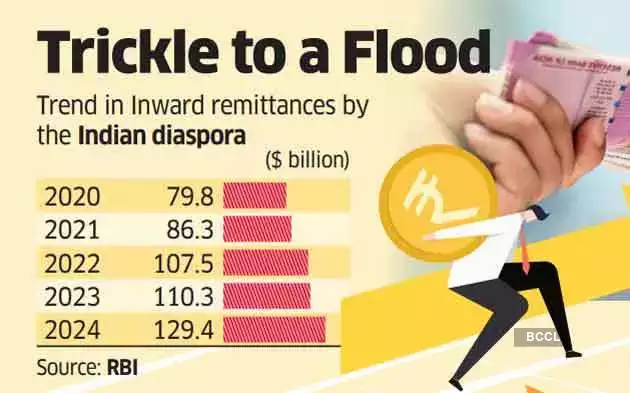India receives over $100 billion remittances for three consecutive years

India’s Remittance Landscape Shifts: FY24 Highlights
Context
India remains the world’s largest recipient of remittances, receiving $129.4–135.46 billion in FY24. This is the third consecutive year that inflows crossed $100 billion, marking a steady upward trajectory since the pandemic. Remittances now account for a stable and significant source of external financing, complementing FDI and exports.
1. Changing Remittance Sources
- Advanced economies now contribute >50% of remittances, reflecting a shift from traditional Gulf sources.
- Top 10 source countries (FY24):
| Rank | Country | Share of Remittances (%) |
|---|---|---|
| 1 | United States | 27.7 |
| 2 | United Arab Emirates | 19.2 |
| 3 | United Kingdom | 10.8 |
| 4 | Saudi Arabia | 6.7 |
| 5 | Singapore | 6.6 |
| 6 | Qatar | 4.1 |
| 7 | Kuwait | 3.9 |
| 8 | Canada | 3.8 |
| 9 | Oman | 2.5 |
| 10 | Australia | 2.3 |
Trend Analysis:
- US: Dominates due to skilled white-collar Indian professionals.
- UAE & GCC: Historically largest contributors, now showing slower growth.
- Singapore, Canada, Australia: Rising shares reflect skilled migration to advanced economies.
2. Drivers of Growth
- Skilled migration: IT, healthcare, finance professionals to US, UK, Canada, Singapore.
- Digital & banking infrastructure: Facilitates remittance transfers efficiently.
- Economic resilience of source countries: Job recovery post-COVID, despite inflationary pressures.
- Global employment patterns: GCC largely blue-collar, advanced economies largely white-collar → higher per capita remittance from US/UK.
3. Economic Implications
- Non-debt financial inflows: Strengthen current account and FX reserves.
- Household income support: Funds family maintenance, education, and healthcare.
- Complement to FDI & services exports: Over 40% of gross current account inflows.
- Macroeconomic stability: Provides a buffer during global shocks (pandemic, inflation, geopolitical tensions).
4. Trends & Projections
- Remittances have more than doubled since 2010–11 ($55.6 billion).
- India’s share in global remittances: 11% (2001) → 14% (2024).
- Projected to reach $160 billion by 2029 (RBI).
- Growth reflects India’s global human capital strength and diaspora networks.
5. Conclusion
India’s remittance inflows demonstrate a structural shift from GCC dependence to advanced economies, driven by skilled migration and professional diaspora networks. These inflows provide stable, non-debt external financing, enhance household incomes, and strengthen macroeconomic stability, positioning India as a resilient, globally integrated economy.
Updated: Apr 17, 2025, 12:22:29 PM | ET